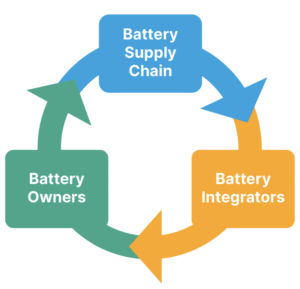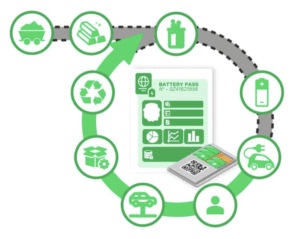The battery passport aims to bring new levels of transparency to the global battery value chain by collecting, exchanging, and reporting trusted data among all lifecycle stakeholders. While the first proof of concept was launched in January 2023 at the World Economic Forum’s Annual Meeting, its origin was conceptualized by the Global Battery Alliance (GBA) in 2019 to highlight the importance of transparency and collective stakeholder action in managing the environmental, social, and governance (ESG) impacts of the rapidly growing battery industry.
In 2020, the GBA outlined a roadmap for creating a global battery passport infrastructure. This included developing a digital ID for batteries that would contain data on their ESG performance, manufacturing history, and material provenance. The initiative gained momentum with the support of various stakeholders, including industry leaders, non-governmental organizations, and government institutions.
While the battery passport is currently a European initiative, its implications and benefits extend globally, including to the United States. In this issue, we delve into the technical aspects of the battery passport, its relevance to the US market, and how Peaxy’s comprehensive solutions and data threading capabilities can support this initiative.
The European Battery Passport Initiative
The European Union’s battery passport regulation, approved in June 2023, mandates that all batteries placed on the EU market must have a digital passport. This passport includes comprehensive data on the battery’s environmental impact, origin, and lifecycle. The primary goals are to improve the traceability and sustainability of batteries, facilitate recycling, and ensure safe handling throughout their lifecycle.
Key components of the battery passport include: Environmental Impact including information on the carbon footprint and other environmental metrics associated with the battery’s production and usage; Origin including details about the raw materials used, including their sources and the conditions under which they were extracted; and Lifecycle including data on the battery’s performance, safety issues, and end-of-life disposal methods. Let’s take a closer look at the way the battery passport measures ESG performance specifically, and what that means for battery OEM’s and integrators/operators.
Environmental Performance
The battery passport plays a crucial role in enhancing the environmental performance of batteries by providing detailed information on their lifecycle impacts, including data on the carbon footprint, energy consumption, and resource utilization during the production, usage, and recycling phases. By tracking these metrics, manufacturers can identify areas for improvement and implement more sustainable practices. For instance, the passport can highlight the use of recycled materials, which reduces the need for virgin resources and minimizes environmental degradation. Additionally, the passport facilitates compliance with environmental regulations, ensuring that batteries meet stringent standards for emissions and waste management.
Social Performance
In terms of social performance, the battery passport ensures that batteries are produced under ethical conditions, promoting fair labor practices and human rights. It includes information on the sourcing of raw materials, ensuring that they are obtained without exploiting workers or violating labor laws. This transparency helps companies avoid supply chain risks associated with unethical practices, such as child labor and unsafe working conditions. Furthermore, the passport supports community engagement and development by encouraging manufacturers to invest in local communities and improve the livelihoods of workers involved in the battery value chain. By fostering social responsibility, the battery passport contributes to building trust and credibility among consumers and stakeholders.
Governance Performance
Governance performance provides a framework for companies to adhere to best practices in corporate governance, including transparency, accountability, and ethical conduct. The passport includes data on compliance with governance standards, such as anti-corruption measures and responsible sourcing policies. This ensures that companies operate with integrity and are held accountable for their actions throughout the battery lifecycle. Additionally, the passport facilitates collaboration among stakeholders, including regulators, manufacturers, and consumers, to promote a sustainable and responsible battery industry.

The circular value chain for batteries is a crucial concept in the battery passport initiative. It illustrates the full lifespan of a battery from raw materials, to manufacture, field deployment and eventual recycling, where some of the materials captured go back into new batteries. Battery analytics capabilities are critical along the entire value chain to address security, safety, sustainability and profitability.
Relevance to the US Market
Although the US does not yet have a formal battery passport requirement, efforts are underway to establish a similar framework. The US is increasingly focusing on battery sustainability and supply chain transparency, driven by the need to stay competitive. The US “Track and Trace” effort aims to create a standardized system for tracking key indicators along the battery supply chain. This initiative will help ensure compliance with emerging regulations and improve the overall sustainability of battery production and usage.
As an example, the Li-Bridge Initiative, launched by NAATBatt International, is a collaborative effort involving government agencies, private companies, and research institutions to develop a comprehensive tracking and tracing system for lithium batteries in the United States. This initiative emerged from a series of government-industry forums aimed at addressing the need for supply chain transparency and sustainability in the battery industry. Participants include representatives from over 50 companies and government agencies, covering the entire lithium battery supply chain. The initiative seeks to create a standardized system for tracking battery contents and performance attributes throughout their lifecycle, enhancing supply chain understanding and efficiency. Future goals include finalizing recommendations for tracking and tracing battery data, improving data interoperability, and fostering industry-wide adoption to support a robust and sustainable lithium battery industry in the US[1].
Data Interoperability in particular will be a significant challenge in ensuring that data from various stakeholders, including manufacturers, recyclers, and regulators, can be seamlessly integrated and accessed is a significant hurdle. This requires developing standardized protocols and systems that can handle diverse data formats and sources. This has been a focus for our customers since launching a battery analytics solution six years ago, with a specialty in data threading.
Peaxy’s Role in Supporting the Battery Passport
Peaxy offers advanced data threading capabilities that can track key cell parameters from supply chain, manufacturing, fleet operations to recycling. Peaxy’s suite of products covers the full battery lifecycle, ensuring comprehensive data management and analysis. Peaxy Innovate and Build help in the design and manufacturing phases, ensuring that every cell’s data is accurately captured and threaded throughout its lifecycle. Peaxy Operate and Predict focus on the operational phase, providing real-time fleet monitoring and predictive analytics to optimize battery performance and lifespan.
One of our recent customers is involved in both the manufacturing and recycling end of life battery energy storage systems. By utilizing Peaxy’s comprehensive suite of solutions, the company gains unprecedented access to the full history of each battery’s formation, manufacture, operation, and disassembly. This end-to-end data visibility significantly addresses data interoperability challenges, ensuring seamless integration and accurate tracking of battery performance and lifecycle metrics. This holistic approach not only enhances operational efficiency but also supports sustainability and compliance with emerging global regulations.

[Credit: NFCW]
Efforts are underway to establish a standardized system for tracking key indicators along the battery supply chain, driven by the need for sustainability and transparency. The Li-Bridge Initiative, involving over 50 companies and government agencies, aims to enhance supply chain understanding and efficiency through comprehensive tracking and tracing of lithium batteries.
Tangible Benefits for Companies
Adopting the battery passport can provide tangible benefits to companies, including financial gains and operational improvements, particularly where second life options come into pay. Here are some examples.
Yield Optimization: Redirecting borderline batteries into alternative applications can significantly lower scrap rates and save costs. By repurposing batteries that may not meet the stringent requirements for primary applications but are still functional for less demanding uses, companies can maximize the value extracted from each battery. This approach not only reduces waste but also enhances overall resource efficiency, contributing to more sustainable battery management practices.
Quality Feedback Loops: Fleet battery analysis during original and second life applications provides valuable insights into degradation patterns, enabling manufacturers to improve their designs and reduce field failure rates. By studying how batteries perform during their life cycle, companies can identify common failure modes and degradation mechanisms. This information can be used to refine manufacturing processes and enhance the durability and reliability of new batteries, ultimately leading to higher quality products and greater customer satisfaction.
Design for Disassembly: Integrating modularity and smart pack design from the outset makes repurposing batteries faster and cheaper. By designing batteries with easy disassembly in mind, manufacturers can simplify the process of extracting and reusing components. This not only reduces the time and cost associated with repurposing but also facilitates more efficient recycling and material recovery, supporting a circular economy for batteries.
Circularity-Driven Procurement: Data on second-life applications can shape sourcing decisions, increasing product lifecycle value. By understanding the residual value and performance capabilities of batteries in their second life, companies can make more informed procurement choices. This approach ensures that materials and components are selected based on their long-term utility and recyclability, enhancing the overall sustainability and economic viability of battery products.
Conclusion
The battery passport is a transformative initiative that promises to enhance the sustainability, traceability, and safety of batteries globally. While currently a European endeavor, its relevance to the US market is growing, driven by the need for improved supply chain transparency and sustainability. Peaxy’s comprehensive suite of battery analytics solutions combined with data threading expertise both play a crucial role in supporting this initiative, ensuring comprehensive tracking and analysis of battery parameters throughout their lifecycle. The economic and social benefits of the battery passport, along with the tangible advantages for companies, make it a valuable tool for driving innovation and sustainability.
References
1 – https://naatbatt.org/new-li-bridge-initiative-on-tracking-and-tracing-lithium-batteries/

